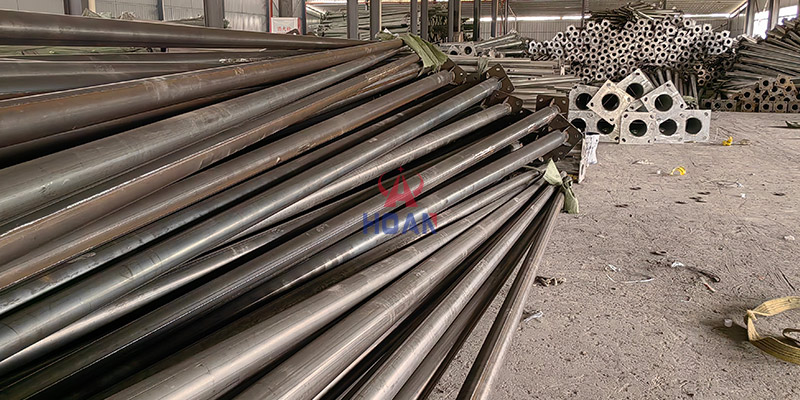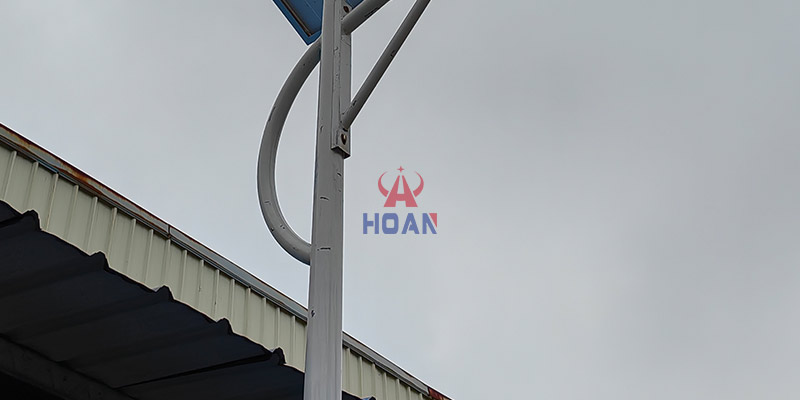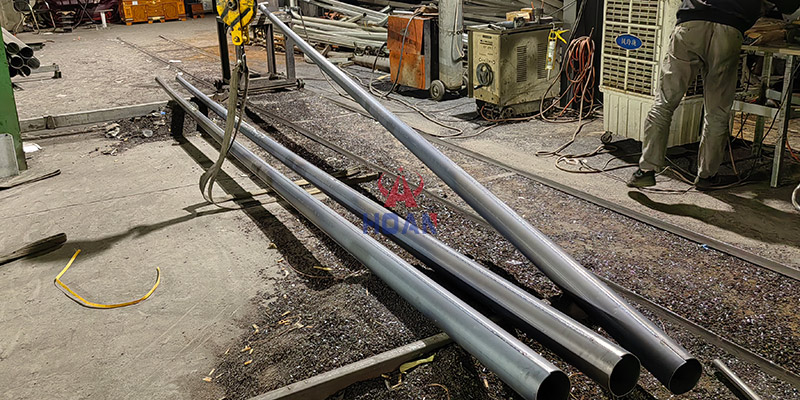Core value of solar street light pole
In the wave of smart city construction and green energy transformation, solar street light poles are becoming a key part of urban infrastructure upgrade. This new type of facility, which integrates lighting, energy collection and intelligent management, breaks the limitation of the single lighting function of traditional street light poles. It not only achieves autonomous power supply through solar energy, reducing the dependence on traditional power grids, but also empowers urban management with intelligent design, becoming an important force in promoting sustainable urban development.
Technical structure & components of solar street light poles
High-efficiency Power Generation Technology
The core power generation component of solar street light poles is the photovoltaic module. Currently, monocrystalline or polycrystalline silicon solar panels are used in the mainstream, and their photoelectric conversion efficiency can be up to 18%-22%. Under sufficient light, a 200W solar panel can generate about 0.8-1 degrees per day. In recent years, new flexible photovoltaic materials have been emerging, which are lightweight and bendable, and are suitable for use on irregular light pole surfaces to further enhance solar energy collection efficiency.
Tilt and Orientation Design
The angle at which solar panels are installed directly affects the amount of power generated. In the northern hemisphere, PV panels are usually tilted towards the south, with the tilt angle adjusted according to the local latitude. For example, at 30°N latitude, solar panels with a tilt angle of 30°-35° can generate optimal power throughout the year. Professional light simulation software can assist in accurately calculating the installation parameters.

Battery Technology Comparison
Lithium battery: high energy density, long cycle life (1000-2000 times charge/discharge), suitable for scenarios with high endurance requirements, but relatively high cost.
Lithium iron phosphate battery: strong safety, high temperature resistance, commonly used in high temperature areas or projects that require long-term stable power supply.
Lead-acid battery: mature technology, low price, but high self-discharge rate, shorter life, suitable for basic lighting needs with limited budget.
Intelligent Management System
BMS is the ‘brain’ of energy storage. It monitors the battery voltage, current, temperature and other parameters in real time, and automatically adjusts the charging and discharging strategy to avoid overcharging and over-discharging. When the battery temperature is too high, the system triggers the cooling protection; when the power is insufficient, it gives priority to reduce the lighting brightness to ensure the power supply in the critical time.
Material and technology
Most of the light poles are made of hot-dip galvanised steel or aluminium alloy. Hot-dip galvanised steel poles are treated with high-temperature zinc dipping, forming a dense anti-corrosion layer on the surface, which can resist acid rain and salt spray, and has a wind resistance rating of 12. Aluminium alloy poles are known for their light weight, which is only 1/3 of that of steel poles, making them easy to transport and install.
Modular assembly
Modern solar street light poles adopt segmented design, with components prefabricated in the factory and bolted together on site by flanges. This modular structure increases the installation efficiency by more than 50%, while reducing the loss during transport.

Third, the core competitive advantages of solar street light poles
Zero carbon emission
Taking a single pole 200W solar street light as an example, it can reduce carbon dioxide emission by about 215kg per year. If a city replaces 1,000 solar street light poles in bulk, the annual emission reduction is equivalent to planting 12,000 trees, which strongly promotes the city's carbon neutral goal.
Low Energy Consumption
The combination of LED light source and intelligent dimming technology realises on-demand lighting. When the traffic flow is reduced late at night, the system automatically adjusts the brightness to 30%-50%, and the average daily energy consumption is more than 60% lower than that of traditional street lights.
Intelligent Lighting
The solar street light pole supports various dimming modes such as light sense, time control and radar sense. Under the light-sensing mode, the system automatically switches on and off the light according to the brightness of the environment; the radar-sensing function instantly increases the brightness when detecting pedestrians or vehicles, realising ‘people come to light, people go to dark’.
Extended Interface
The light pole is reserved for 5G micro base station, charging pile, environmental monitoring sensors and other equipment interfaces. For example, street light poles equipped with PM2.5 sensors can upload air quality data in real time, providing data support for urban environmental management.
| Compare Projects | Solar Street Light Pole | Traditional street light pole |
| Initial investment | Higher (including photovoltaic + energy storage) | Lower |
| 10-year operating costs | Low (zero electricity bill + low maintenance) | High (electricity costs account for 70%+) |
| Comprehensive cost | Economical in 3-5 years | Continuously high costs |
Diversified application scenarios of solar street light poles
Main road application
In the main road of the city, 12m high pole street light is equipped with more than 200W high power LED lamps, the lighting radius is up to 30 metres, to meet the strong light demand of six lanes in both directions. Intelligent dimming function ensures the safety of driving at night while avoiding light pollution.
Sidewalk/Community
The 8m short pole street light is suitable for community roads, its warm yellow light effect creates a warm atmosphere. Combined with the human body sensor technology, the street light automatically brightens when residents approach, ensuring safe travelling at night.
5G Micro Base Station Carrier
5G network construction requires high density of base stations, and solar street light poles have become an ideal carrier for micro-base stations. Its stable power supply and layout all over the city can effectively solve the 5G signal coverage problems.
Internet of Things Node
By integrating temperature, humidity and noise monitoring sensors, street light poles are transformed into urban IoT nodes. The data collected in real time is uploaded to the management platform to assist the government in environmental management and traffic scheduling.
Remote areas
In mountainous areas, islands and other areas without power grids, the independent power supply system of solar street light poles plays a key role. In an island project, the solar street light poles still maintain normal lighting for 15 consecutive days of rainy and cloudy days to protect the residents' travelling at night.
Landscape/Park
Customized artistic light poles are integrated with landscape design, such as imitation wood grain light poles suitable for ecological parks, and colourful LED light strips to create a festive atmosphere. Both functional and ornamental, enhance the attractiveness of the scenic area at night.

Installation and maintenance guide of solar street light pole
Pre-survey
Light resource assessment is required before installation to ensure that the average daily light duration is ≥4 hours. Meanwhile, geological bearing test should be carried out to avoid tilting of the pole due to soft ground. If it is necessary to connect to the power grid as a backup power source, it is necessary to plan the line in advance.
Construction Steps
Daily Inspection
Clean the surface of PV panels of dust, bird droppings and other stains every month, and check whether the anti-corrosion coating of the light pole is broken. Discover loose bolts or aging cables and deal with them in time.
Professional Inspection
Use professional equipment to test the battery capacity every quarter, and consider replacing it when the capacity drops to 80%. Conduct a comprehensive line check once a year to ensure long-term stable operation of the system.
Industry Cases and Market Trends
Domestic Cases
The intelligent street light pole deployed in Xiong'an New Area integrates 5G base station, charging pile, video monitoring and other functions, and the average annual power generation of a single pole reaches 4,380 kWh, making it a model for smart city construction.
International Cases
The solar street light poles in Singapore's Marina Bay are equipped with an environmental monitoring system that uploads air quality data in real time, and its intelligent dimming technology reduces energy consumption by 40%.
Policy Driven
The national ‘dual-carbon’ target and new infrastructure policy clearly support the development of solar street light poles, and many governments have introduced subsidy policies, such as subsidising 30% of the installation cost of each street light.
Technological innovation
Breakthroughs have been made in the research and development of chalcogenide photovoltaic materials, and the conversion efficiency in the laboratory has reached 33%; the AI intelligent control system can predict the light intensity and optimise the power supply strategy according to the historical data, which has pushed the industry's technology iteration.
With the core advantages of green energy saving, intelligent integration and cost control, solar street light poles are becoming an inevitable choice for urban lighting upgrade. It not only solves the pain point of traditional street light with high energy consumption and single function, but also promotes the construction of smart city with multi-functional characteristics. We expect municipal departments, engineering enterprises and energy agencies to work together to accelerate the popularity of solar street light poles and jointly build a sustainable urban future.